eAccess to the singletrack
How riders, clubs and landowners are working to integrate the new machines into their networks
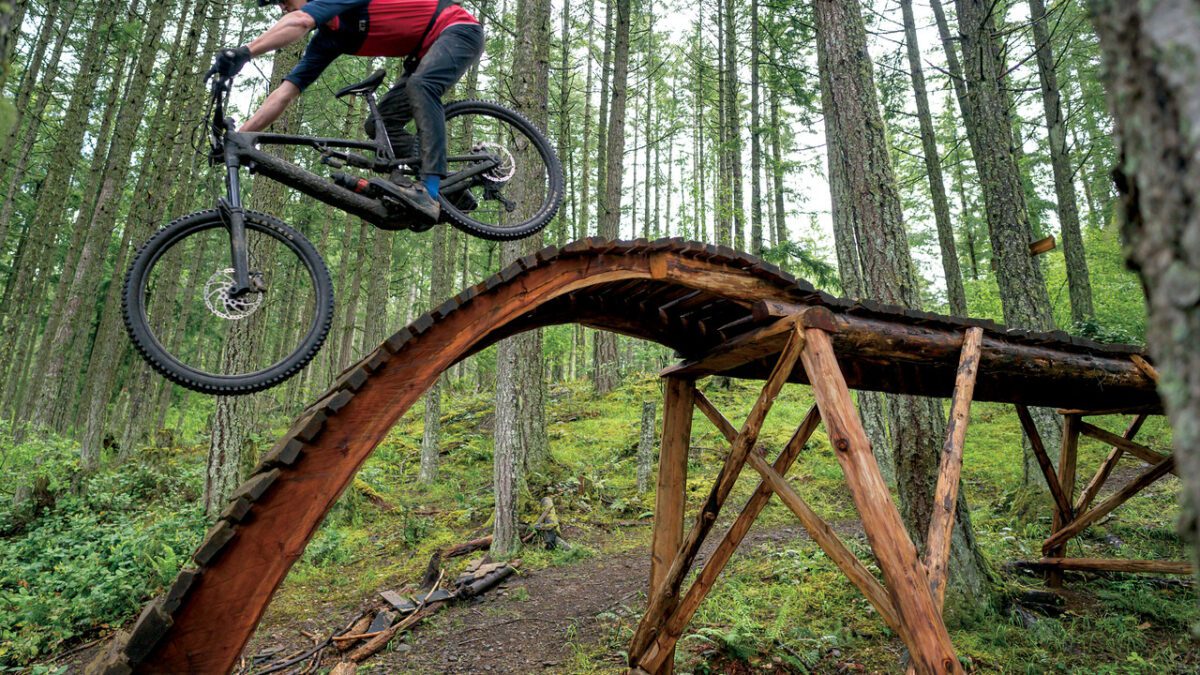
by Tara Nolan
We’ve all seen the influx of new cyclists on bikes. They’re on road bikes, gravel rigs, mountain whips and even, as my friend adorably calls cruisers, doo-di-doos. Ebikes and trail-focused eMTBs are very much a part of that surge. Those battery-powered bikes may have taken some flak by analog purists as the new models emerged. But it seems the derision, as well as pro/anti debates, are fading, somewhat. There are occasional headlines when new policies are implemented or disagreements occur in a community over fresh rules that either ban or allow them. Since the pandemic has brought a lot more people outdoors and on the trails, there have been more voices and opinions added to the mix throughout the past two years.
With eMTBs, the conversation is evolving as landowners and stakeholders across Canada try to define the parameters around which types of battery-powered bikes should be granted access to singletrack—and which trails are off limits. All parties face tough questions. As eMTBs gain in popularity, how do trail networks adapt? Who makes the final call around policies when there are multiple landowners, regions and conservation authorities involved? What discussions should be had around ecology and ableism? How does a club or landowner communicate etiquette to new trail users? How are rules enforced? How do we welcome all users to our beloved sport?
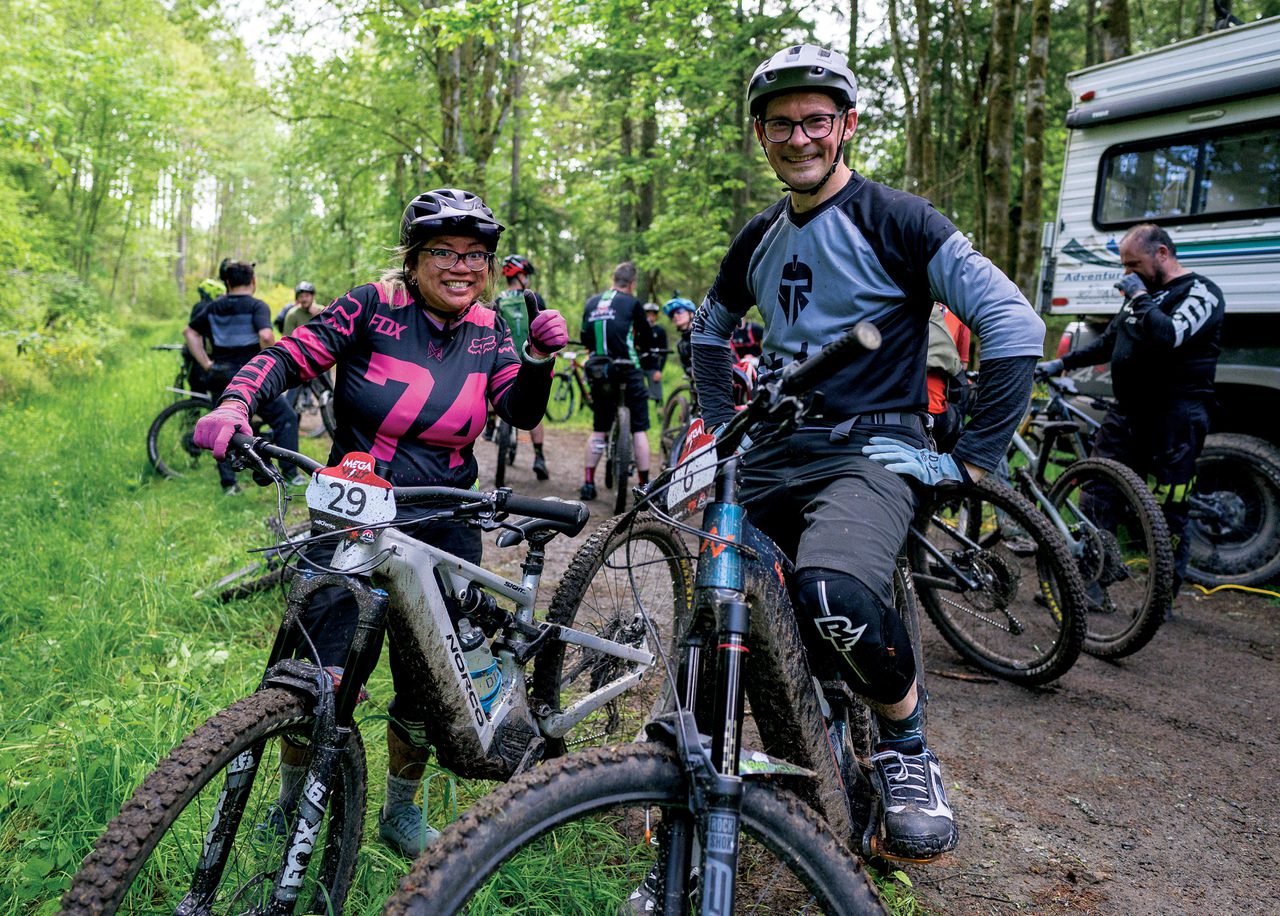
What, exactly, do you mean by eMTB?
When we speak of ebikes—you, me, other writers in this magazine—we mean pedal-assist bikes. No throttles. But the term ebike is often used for machines with throttle-assist. Those ebikes can get lumped into a category that also includes scooters and motorbikes. Language really needs to evolve with the different types of bikes now available.
What does seem to be pretty standard is the definition of the type of ebike allowed on mountain bike trails across the country: the bike must be pedal-assist, reaching a maximum speed of 32 km/h with an electric motor of 500 W or less. These bikes fall under the category of Class 1 ebikes. They are also called pedal-assist mountain bikes, or simply eMTBs.
IMBA Canada uses much of the same language, as do provincial regulatory bodies. “IMBA Canada is against the use of throttle-controlled ebikes,” the organization writes on its website, “and believes that only those which are activated by the use of pedalling should be considered on mountain bike trails in any context.”
e-welcoming trails
One of the first land areas to establish an official eMTB policy was the Cowichan Valley on Vancouver Island. Matt Grossnickle, a current board member and former president of the Cowichan Trail Stewardship Society was an early advocate for integrating eMTBs into trail networks. “Proper management is the way to go, rather than straight-up bans, because they just don’t work,” he says. As one of the owners of Cycle Therapy in Duncan, he saw where industry trends were inevitably headed as ebikes grew in popularity in Europe and then started gaining traction in North America.
After the region hosted the BC Bike Race in 2018 and 2019, it was tapped to run the BCBR Mega Volt, an eMTB-based event, in 2021. “I thought when we launched the race, we’d get a lot of hate,” he says. “But that was not the case.” Grossnickle regards eMTBs as a segment of the sport. But he is realistic about the benefits, as well as the challenges. Riders can now get deeper into the backcountry more quickly and more easily than they could before. If they are not properly prepared, they could face trouble. Some trailside fixes can be more of a struggle. How far are you hiking out if your bike is beyond repair?
Another big safety issue comes when riders climb what are typically considered to be downhill trails. That two-way traffic could lead to serious consequences.
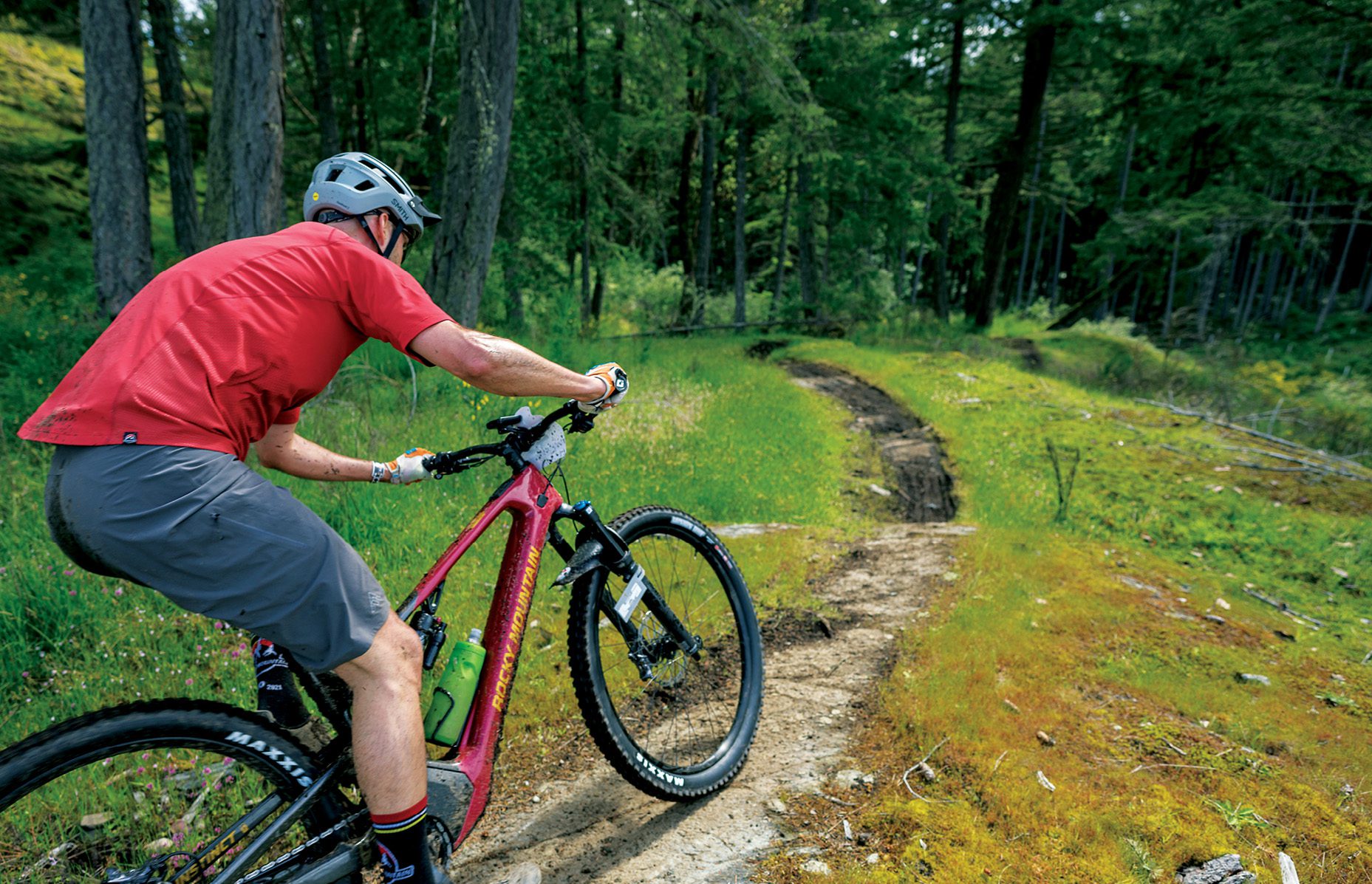
Providing direction, going up and going down
In Whistler, Trevor Ferrao, executive director of the Whistler Off Road Cycling Association (WORCA) explains how the practice of riders going up trails primarily intended for descending was raised as a concern on their singletrack. “We added signage to make people more aware of that for safety,” he says. Another main concern is general wear and tear, though it can be hard to tell if specific damage is done by eMTBs or MTBs. “With WORCA, we really just maintain the trails and make sure they’re safe for everyone to use,” Ferrao adds.
Backcountry access is also carefully considered as part of the policy that was established in 2019. “Access is determined through a number of ways,” explains Penelope Buswell Lafrance, communications officer for the Resort Municipality of Whistler (RMOW). “It’s through community and stakeholder (specifically WORCA) engagement, as well as with consideration of ebike policies set by senior levels of government for areas in Whistler (recreation sites, Trails BC and BC Provincial Parks) and provincial Motor Vehicle Act regulations. We also consider the reality of search-and-rescue access, and values related to environment and trail-user experience.”
Over in Revelstoke, B.C., provincial policies inform that area’s guidelines, but there are specific exceptions. “We polled our membership on multiple occasions to ask what they wanted to see on our trails,” says Meghan Tabor, president of the Revelstoke Cycling Association. The polls determined, for example, that there were safety concerns on Frisby Ridge. Though some think it’s due to the presence of caribou, the ban of eMTBs stemmed from the risk of collisions between ebikers speeding up and fast downhill riders coming down. “Frisby Ridge is a two-way trail in a fragile alpine environment where people already ride too fast downhill, leading to many close calls,” Tabor explains. “We are looking at ways to alleviate this in the future. There’s potential for separate up and down trails. However, right now, it is an extremely busy trail with user conflicts that we are trying to manage.” All the other networks at Revelstoke permit eMTBs, which is based on the provincial policy.
A new challenge for trail design
As uphill/downhill debates over trail usage go on, trail design is evolving. “What I think will be most interesting to learn about eMTBs, given their different dynamics and their different system of psychological interface in the trail systems, is how they will show us things we haven’t seen before,” says AJ Strawson, the executive director of IMBA Canada. He thinks new ideas in trail design, especially on climbing trails, could potentially offer ways to manage safety. “People are using eMTBs to climb trails that are traditionally descending priority—maybe not flagged, but culturally and socially, just descending. Should we be trying to build challenging climb trails for eMTB and MTB alike? I think some of those unique things will pop up.”
“If you show up with any bike, do you know what all the regulations are and do you know whose land you’re actually on?”
Grossnickle also figures that trail design will change. “I can see a future of ebike-specific trails or different ratings,” he adds.
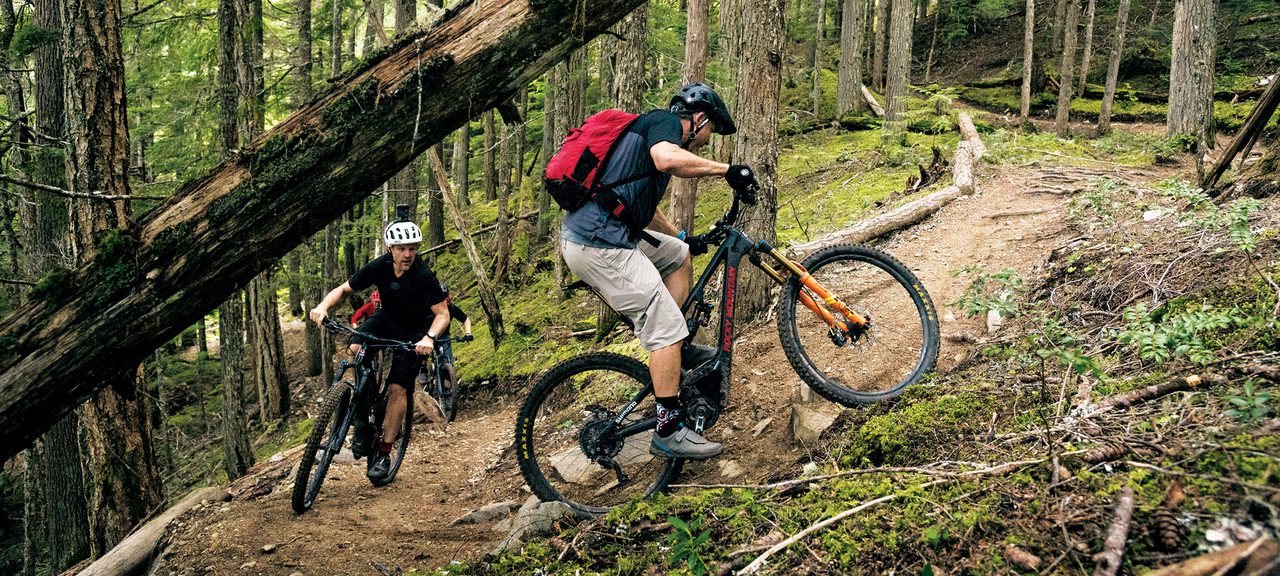
Unveiling policies and updating infrastructure
Bike-trail networks in other provinces are also putting eMTB policies on their websites. You can often see on Trailforks which trails are open to them. For one-way trails, like the ones at the Hydrocut in Waterloo, Ont., and others throughout Eastern Canada that are more loop-based, the ascending/descending debate from the West Coast is moot. But policies still need to be made for a myriad of other reasons.
Surprisingly, according to Strawson, IMBA hasn’t had anybody reach out to say they need specific policy language. Setting out protocols can be complicated given how many stakeholders might be a part of a single trail network, from private landowners to conservation authorities and municipalities. But gradually, groups make progress.
In a Facebook post from 2021, for example, the Hydrocut posted, “Well, after many (many!) meetings and discussions, both amongst our committee and with the Region of Waterloo, and in adherence to the region’s stance on the topic, Class 1 ebikes…are currently admissible in Region of Waterloo trail systems, including the Hydrocut.”
At various networks in different provinces, from Sugarloaf Bike Park in New Brunswick to Vallée Bras-du-Nord in Quebec, Class 1 ebikes are currently permitted. For other trail networks in Canada, it seems as though there is still some figuring out to do. In general, infrastructure needs to catch up, says Grossnickle. “COVID and the mass outdoor-recreation boom gave us the opportunity to envision what mountain biking is to a community and what mountain bike infrastructure is required,” he explains.
Good etiquette and the odd bad seed
As with all cycling, good etiquette is necessary. As we’ve seen even on roads and recreational trails that are mixed-use, there can be good cyclists and bad cyclists. The bad ones, unfortunately, can ruin everyone’s reputation. “If you show up with any bike, do you know what all the regulations are and do you know whose land you’re actually on?” says Strawson. “That’s a problem that’s not just related to ebikes.”
“We try to promote good trail etiquette to reach as many people as possible, so all trail users are happy and working collectively,” says Ferrao of WORCA’s communication initiatives.
Part of the challenge, though, is this new technology. The difference in speed can be startling, especially to newer riders on the trail. The hope is that those on eMTBs can be mindful of how their presence can affect other riders, especially on busier trails.
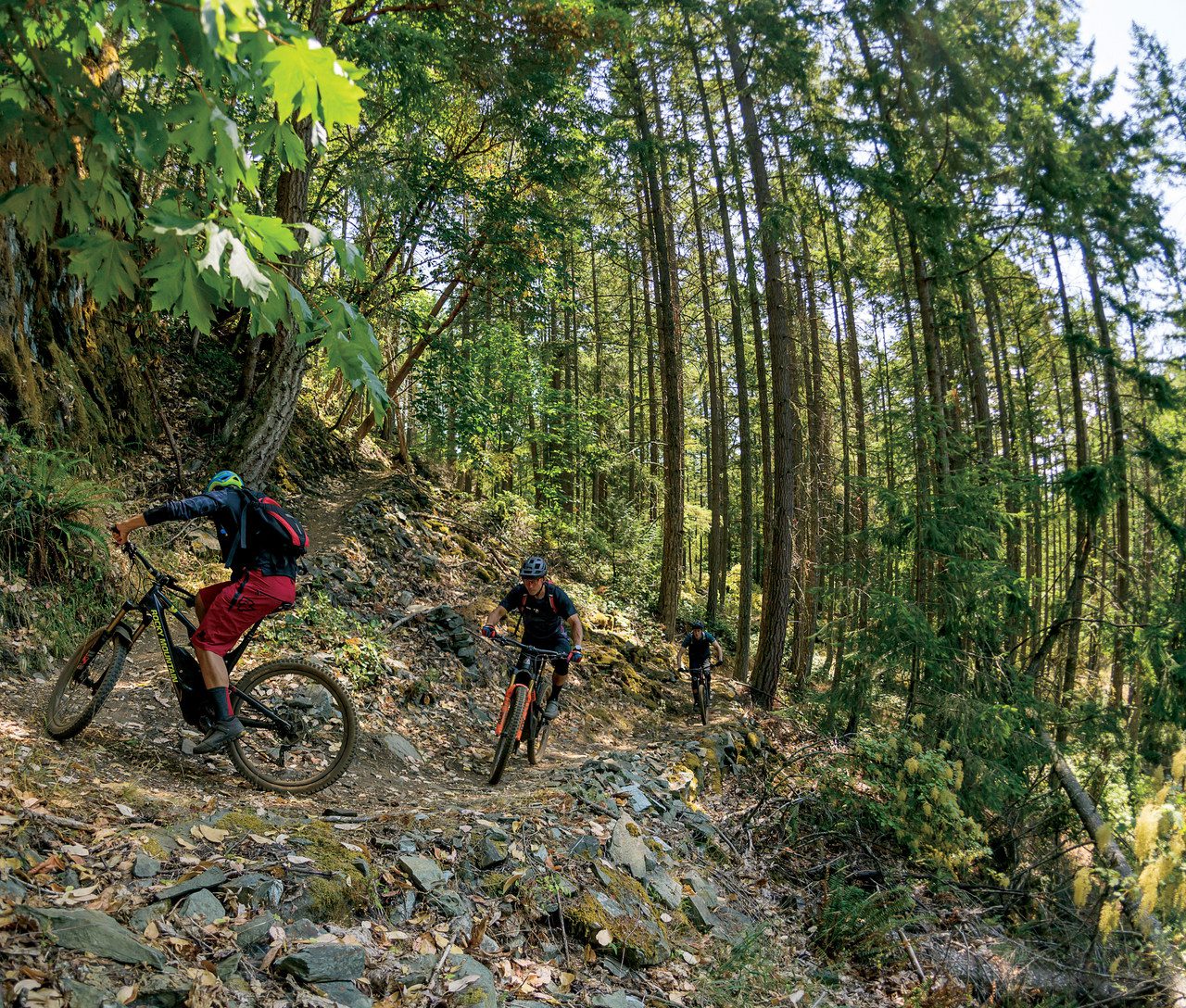
Balancing ecological concerns
Of course, the environment is always taken into consideration when establishing trail development and usage rules for everyone, whether they are on bikes or on foot. Mixed-use singletrack can be obliterated by hikers on muddy days just as it can by bikes. At Whistler, for example, though the resort municipality follows provincial guidelines for ebikes, it makes an exception for alpine trails, like Lord of the Squirrels. Those trails are off limits to pedal-assist machines.
In Jasper National Park and Banff National Park, ebikes are permitted on certain trails. But in a written statement, Parks Canada explained that “in order to ensure the safety of our visitors and maintain ecological integrity in national parks, the use of pedal-assist ebikes is limited to select trails with low potential for impacts to the environment and other visitors’ experiences.”
Attracting new riders
What’s important as everything falls into place with eMTB policies is clear communication at trail kiosks, via social media, on apps and websites. More people on bikes has been a boon to the industry, one that all riders hope continues long past the current bike and parts shortages.
In Europe, ebikes have greatly benefitted tourism. While Canada is not totally there as far as attracting visitors for eMTB-specific trips, you are starting to see tourism guides that make eMTB riding part of their activity suggestions.
In Duncan, Grossnickle says the first tourists who came into the store did so because of the BCBR Mega Volt. They were from Switzerland. So it’s starting. But it’s also gaining traction from a local perspective.
Tabor says that Revelstoke is seeing more eMTBs on trails where they’re permitted. “I think we are going to continue to see the momentum as ebikes get lighter, potentially more affordable, and as the mountain biking sector ages,” she says. That leads to one last point about eMTBs.
Making mountain biking accessible to everyone
Pedal-assist mountain bikes can get many more folks onto trails: those who may not be able to ride classic mountain bikes or those whose fitness may hinder them from riding.
“Supporting new activities,” writes Parks Canada, “such as pedal-assist ebikes, allows Parks Canada to meet the evolving needs and expectations of visitors, enabling more Canadians, of varying backgrounds and abilities, to discover and connect with nature in new and innovative ways. Pedal-assist ebikes also provide greater accessibility for people who could not otherwise discover Parks Canada administered places.”
IMBA’s message around accessibility is clear: ebikes can further the mission of ensuring that Canada is home to a strong and vibrant mountain biking community by allowing those with disabilities to be involved in mountain biking.
“We’re expanding opportunities for people to be able to experience mountain biking,” Strawson says. “I think that’s a really important step in making sure we are sharing our public lands with the public at large and not being exclusive, so everyone can experience the benefits of being outside and welcoming them onto our trails.”
This story originally appeared in the August/September 2022 issue of Canadian Cycling Magazine
